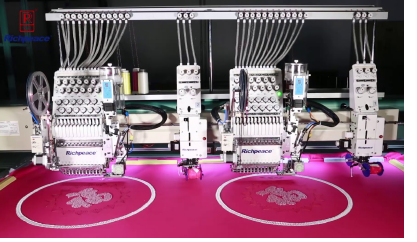
El tipo de fijación es independiente del tipo de dispositivo. El canutillo se descarga en la misma forma siempre. Las puntadas de fijación controlan la orientación del canutillo. Sin embargo, las diferentes máquinas y dispensadores tienen sus propios requisitos e idiosincrasias de producción.

La producción de canutillos es más exigente que la producción de lentejuelas. Mientras los dispositivos de lentejuelas tenían los mismos problemas, han madurado al punto de que pueden manejar todos los tipos de fijación a alta velocidad. Además, los materiales de las lentejuelas son más flexibles. Las penetraciones de aguja generalmente no causan problemas serios. La velocidad de operación comercial mínima para la producción de canutillos es 800 rpm o superior. Problemas típicos que se pueden presentar a alta velocidad:
3Canutillos faltantes
3Canutillos aplastados
3Agujas rotas.
Puede necesitar modificar o ‘afinar’ los tipos de fijación predefinidos suministrados por el software para correr en forma confiable a alta velocidad. Esto requerirá hacer pruebas en la máquina. Aunque las puntadas de fijación en EmbroideryStudio se adaptan automáticamente al tamaño del canutillo, cada tipo de canutillo debe probarse por separado. En general, la producción de canutillos puede estabilizarse corriendo las máquinas a baja velocidad, por ejemplo, a 600 rpm. Esto es apropiado para pruebas.
Un escenario típico puede ser:
3Desarrolle un diseño de bordado de canutillos.
3Lleve a cabo una prueba a baja velocidad.
3Pruebe a velocidad de producción para calcular costos.
3Evalúe si la fijación de los canutillos a alta velocidad cumple con los requisitos – p. ej. si hay canutillos faltantes o aplastados.
3Ajuste las fijaciones de canutillos y pruebe de nuevo.
Las opciones disponibles en EmbroideryStudio para los diseñadores de canutillo son:
3Modificar o ‘afinar’ las puntadas de fijación mediante las propiedades del objeto. Esto puede implicar:
3Probar diferentes tipos de puntada de fijación
3Probar tanto espaciados automáticos como fijos
3Modificar configuraciones de margen.
3Editar fijaciones de canutillo con la herramienta Editar canutillos.
3Digitalizar descargas de canutillos con la herramienta Canutillo manual.
3Insertar descargas de canutillo con la prestación Insertar función.
3Crear sus propias fijaciones de canutillo y guardarlas como motivos personalizados.